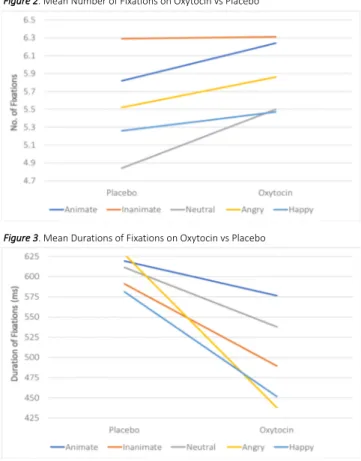HAL Id: hal-02354695
https://hal.archives-ouvertes.fr/hal-02354695
Submitted on 18 Nov 2019
HAL is a multi-disciplinary open access
archive for the deposit and dissemination of
sci-entific research documents, whether they are
pub-lished or not. The documents may come from
teaching and research institutions in France or
abroad, or from public or private research centers.
L’archive ouverte pluridisciplinaire HAL, est
destinée au dépôt et à la diffusion de documents
scientifiques de niveau recherche, publiés ou non,
émanant des établissements d’enseignement et de
recherche français ou étrangers, des laboratoires
publics ou privés.
Oxytocin Enhances Visual Attention to Facial Stimuli in
Patients with Schizophrenia : Evidence from an
eye-tracking study
Lilla Porffy, Rebekah Wigton, Antoine Coutrot, Dan Joyce, Isabelle
Mareschal, Sukhi Shergill
To cite this version:
Lilla Porffy, Rebekah Wigton, Antoine Coutrot, Dan Joyce, Isabelle Mareschal, et al.. Oxytocin
Enhances Visual Attention to Facial Stimuli in Patients with Schizophrenia : Evidence from an
eye-tracking study. Schizophrenia International Research Society Conference, Apr 2018, Florence, Italy.
Schizophrenia Bulletin, 44 (S1), pp.S249, 2010. �hal-02354695�
Oxytocin Enhances Visual Attention in Patients with
Schizophrenia: Evidence from an Eye-tracking Study
Lilla Porffy
1, Rebekah Wigton
2, Antoine Coutrot
3, Dan Joyce
1, Isabelle Mareschal
4, Sukhi Shergill
11Department of Psychosis Studies, Institute of Psychiatry, Psychology & Neuroscience, King's College London, UK; 2Department of Neurology, Beth Israel Deaconess Medical Center, Boston, Massachusetts, US; 3Institute of Behavioural Neuroscience, University College London, UK; 4Biological and Experimental Psychology, School of Biological and Chemical Sciences, Queen Mary University of London, UK
References: Kohler, C. G., Walker, J. B., Martin, E. A., Healey, K. M., & Moberg, P. J. (2010). Facial emotion perception in schizophrenia: A meta-analytic review. Schizophrenia Bulletin, 36(5), 1009–1019; Manor, B. R., Gordon, E., Williams, L. M., Rennie, C. J., Bahramali, H., Latimer, C. R., … Meares, R. A. (1999). Eye movements reflect impaired face processing in patients with schizophrenia. Biological Psychiatry, 46(7), 963–969; Averbeck, B. B., Bobin, T., Evans, S., & Shergill, S. S. (2012). Emotion recognition and oxytocin in patients with schizophrenia. Psychological Medicine, 42(2), 259–266.
BACKGROUND
METHODS
Twenty right-handed male participants with schizophrenia or schizoaffective disorder were administered intranasal oxytocin 40UI or placebo in a double-blind, placebo-controlled, cross-over fashion during two visits separated by 7 days.
Participants engaged in a free-viewing eye-tracking task, looking at images of Caucasian men displaying angry, happy, & neutral facial expressions and control images including animate and inanimate stimuli.
Social cue processing, particularly face perception, plays a critical role in social cognitive functioning. Patients with schizophrenia struggle to extract information from faces and interpret facial expressions (Kohler et al., 2010). Indeed, eye-tracking studies have demonstrated that schizophrenia patients exhibit reduced exploratory behaviour (i.e. reduced number of fixations and longer fixation duration) in response to facial stimuli compared to healthy controls (e.g. Manor et al., 1999), suggesting restricted visual attention. The neuropeptide, oxytocin has been demonstrated to exert pro-social effects on behaviour and modulate eye gaze during face perception. In this study, we tested whether oxytocin has a compensatory effect on visual processing of human faces.
RESULTS
DISCUSSION
Figure 1. Examples of facial and control stimuli
Repeated-measures ANOVA were carried out to explore the within-subject effects of treatment (oxytocin vs. placebo), stimuli (angry / happy / neutral / animate / inanimate), and the interactions between stimuli and treatment (p < .05, two-tailed).
Total number of fixations: Main effect of treatment (F1,17 = 5.604, p =
.030); Main effect of stimuli (F4,68 = 5.008, p = .001).
Duration of fixation: Main effect of treatment (F1,13 = 4.791, p = .047);
Main effect of stimuli (F4,52 = 1.382, p = .253).
Dispersion:No main effect of treatment; Main effect of stimuli (F4,68 = 2.998, p = .024).
Saccade amplitudes:No main effect of treatment; Main effect of stimuli (F4,68 = 0.289, p = .008).
None of the interactions reached significance.
Figure 2. Mean Number of Fixations on Oxytocin vs Placebo
Figure 3. Mean Durations of Fixations on Oxytocin vs Placebo
In this study, oxytocin enhanced exploratory viewing behaviour by increasing the total number of fixations, whilst reducing the mean duration of fixations compared to placebo. These results indicate that acute administration of intranasal oxytocin has the potential to enhance visual attention and improve social cognitive deficits in schizophrenia (Averbeck et al., 2012). The absence of any interaction effects may warrant future studies into oxytocin-induced eye movement changes and facial emotion recognition in larger samples.
Primary outcomes: 1) Total number of fixations 2) Mean duration of fixations
Secondary outcomes: 3) Dispersion 4) Saccade amplitudes
